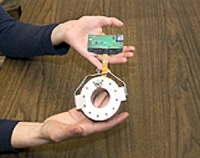Miniature PET scanner aids study of animal brain function
Scientists from the Brookhaven National Laboratory have developed a wearable, portable PET scanner for studying the brain function of animals such as rats.

’Positron emission tomography [PET] is a powerful tool for studying the molecular processes that occur in the brain,’ said Paul Vaska, head of PET physics at Brookhaven, who led the development of the portable scanner together with Brookhaven colleagues David Schlyer and Craig Woody.
But studying animals with PET has required general anaesthesia or other methods to immobilise the animals.
’Immobilisation and anaesthesia make it impossible to simultaneously study neurochemistry and the animals’ behaviour — the actions resulting from what goes on in the brain,’ Schlyer said.
’Our approach was to eliminate the need for restraint by developing a PET scanner that would move with the animal, thus opening up the possibility of directly correlating the imaging data with behavioural data acquired at the same time,’ he added.
The miniature, portable, doughnut-shaped PET scanner can be worn like a collar on a rat’s head for simultaneous studies of brain function and behaviour.

Register now to continue reading
Thanks for visiting The Engineer. You’ve now reached your monthly limit of news stories. Register for free to unlock unlimited access to all of our news coverage, as well as premium content including opinion, in-depth features and special reports.
Benefits of registering
-
In-depth insights and coverage of key emerging trends
-
Unrestricted access to special reports throughout the year
-
Daily technology news delivered straight to your inbox










Water Sector Talent Exodus Could Cripple The Sector
Maybe if things are essential for the running of a country and we want to pay a fair price we should be running these utilities on a not for profit...